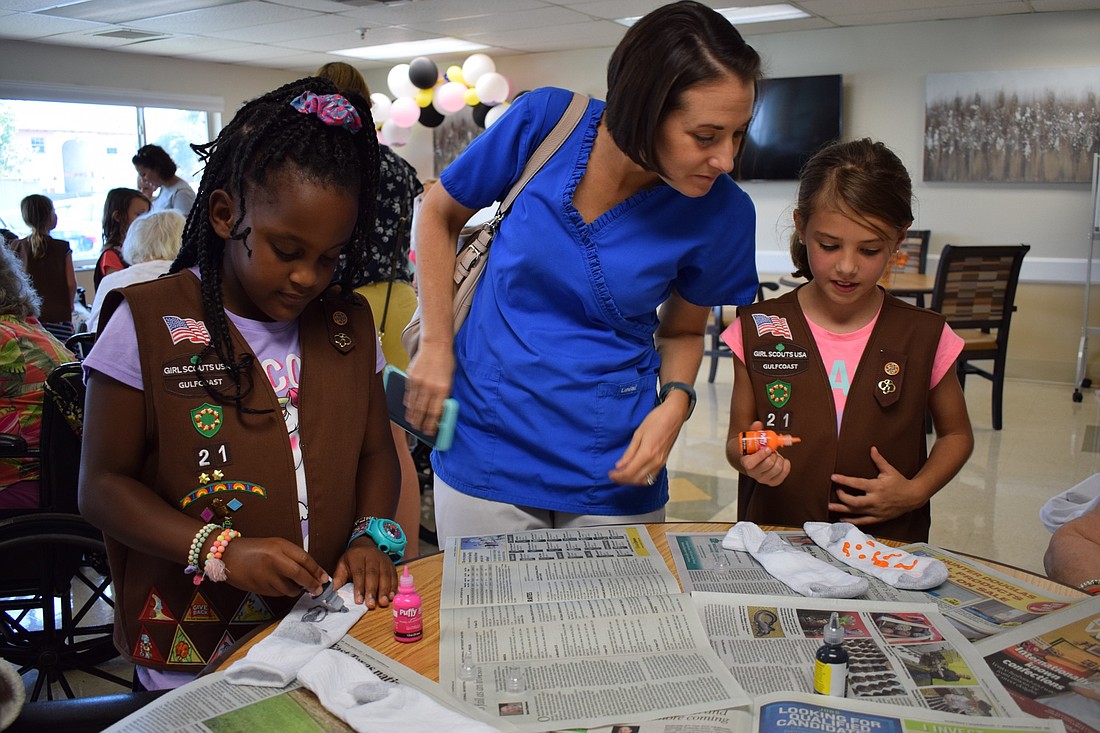- November 15, 2024
-
-
Loading

Loading

When Michelle Cramer’s daughter Raegan started kindergarten in 2017, she knew she wanted Raegan to join Girl Scouts.
To provide the opportunity for her daughter to be a part of the volunteer-led, girls-only organization, Cramer also knew she would have to step up.
“I knew for Raegan to have this experience, I was going to have to start a troop,” Cramer said. “There are just not a lot of people jumping on for volunteering, and that’s what we’re trying to change.”
Girl Scout Troop 21 is one of 46 troops currently in the Lakewood Ranch area serving 700 girls, but dozens of families are still looking for a troop to join.
The organization has about 100 inquiries for girls not yet placed in a troop in Lakewood Ranch.
“For my troop, if I could take 100 girls, I would, but I can’t,” Cramer said. “There are second graders I had to turn away. We hope that we can find them another troop, but right now I’m at capacity. And if I take on other girls, then it takes away from those girls [in the troop]. It’s so critical we get more parent volunteers.”
Girl Scouts of Gulfcoast Florida hosted informational troop-building nights at elementary schools throughout the area to find not only girls interested in joining the organization but also people willing to be volunteers. About 300 adult volunteers — who include leaders, co-leaders and troop support — are serving in the area.
Roberta Rodgers, Girl Scouts of Gulfcoast Florida member-engagement manager, said that on average, 10 to 15 families attend troop-building nights.
“I don’t think people realize there’s such a need for [volunteers],” Rodgers said. “They don’t realize that there’s a gap, that we have girls that possibly might not be able to be in Girl Scouts because we don’t have volunteers to lead those troops.”
Rodgers said about 10 new troops are in the process of getting started in Lakewood Ranch as a result of the troop-building nights. Troops typically have 12 to 15 girls, depending on the number of adult volunteers.
“I think it’s phenomenal,” Rodgers said. “It’s a great feeling to know we’re going to be able to serve those new girls. That’s 120 to 150 new potential girls in the area. … It’s a great start for the area.”
Troop 17 leader Jodi Kudelko volunteered during a troop-building night when her now 10-year-old daughter, Elise, was in kindergarten. Having been a Girl Scout for five years when she was younger, Kudelko thought her experience could help lead the troop, so she volunteered.
Cramer, who is also a co-leader for her 10-year-old daughter Sydney’s troop, said she thinks if more people knew what Girl Scouts was providing for girls, more people would volunteer.
Through her troop, Cramer said Sydney has made new friends, found a sense of community and learned about philanthropy, outdoor skills and cooking, as well as learned about science, technology, engineering and mathematics.
“It’s such a well-rounded program that she gets all these different experiences, and that was so important to me,” Cramer said.
Kudelko said her daughter was “super shy” before joining the organization, but now she always wants to run troop meetings and has demonstrated several leadership capabilities. Kudelko goes to some of the troop-building nights to have conversations with the parents and let them know she’s there to support them if they’re interested in becoming a leader.
A common misconception about volunteering is the idea that a person has to have a daughter in the organization. Anyone, whether a former Girl Scout or a community member, is welcome into the volunteer program.
Rodgers and Cramer also said people often think being a troop leader can be time-consuming, but the leaders choose how often the troop meets as well as the location and time.
Besides recruiting volunteers, Kudelko said finding places to host meetings can be difficult, but more community exposure could alleviate the issue.